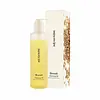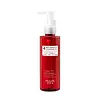What's inside
What's inside
 Key Ingredients
Key Ingredients

 Benefits
Benefits

 Concerns
Concerns

 Ingredients Side-by-side
Ingredients Side-by-side

Oryza Sativa Bran Oil 71%
EmollientIsopropyl Myristate
EmollientSorbeth-30 Tetraoleate
EmulsifyingCaprylic/Capric Triglyceride
MaskingCetyl Ethylhexanoate
EmollientTocopheryl Acetate
AntioxidantWater
Skin ConditioningMoringa Oleifera Seed Oil
EmollientCamellia Japonica Seed Oil
EmollientMacadamia Ternifolia Seed Oil
EmollientHelianthus Annuus Seed Oil
EmollientOlea Europaea Fruit Oil
MaskingLimnanthes Alba Seed Oil
Skin ConditioningRosa Canina Fruit Oil
EmollientGlycine Soja Oil
EmollientCarapa Guaianensis Seed Oil
Skin ConditioningCamellia Oleifera Seed Oil
Skin ConditioningSimmondsia Chinensis Seed Oil
EmollientOenothera Biennis Oil
EmollientArgania Spinosa Kernel Oil
EmollientCamellia Sinensis Leaf Oil
AntioxidantPersea Gratissima Oil
Skin ConditioningButylene Glycol
HumectantBertholletia Excelsa Seed Oil
EmollientGalactomyces Ferment Filtrate
HumectantVigna Radiata Seed Extract
Skin ConditioningLens Esculenta Fruit Extract
Skin ConditioningHippophae Rhamnoides Fruit Extract
Skin Conditioning1,2-Hexanediol
Skin ConditioningHovenia Dulcis Fruit Extract
Skin ConditioningEthylhexylglycerin
Skin ConditioningTocopherol
AntioxidantParfum
MaskingOryza Sativa Bran Oil 71%, Isopropyl Myristate, Sorbeth-30 Tetraoleate, Caprylic/Capric Triglyceride, Cetyl Ethylhexanoate, Tocopheryl Acetate, Water, Moringa Oleifera Seed Oil, Camellia Japonica Seed Oil, Macadamia Ternifolia Seed Oil, Helianthus Annuus Seed Oil, Olea Europaea Fruit Oil, Limnanthes Alba Seed Oil, Rosa Canina Fruit Oil, Glycine Soja Oil, Carapa Guaianensis Seed Oil, Camellia Oleifera Seed Oil, Simmondsia Chinensis Seed Oil, Oenothera Biennis Oil, Argania Spinosa Kernel Oil, Camellia Sinensis Leaf Oil, Persea Gratissima Oil, Butylene Glycol, Bertholletia Excelsa Seed Oil, Galactomyces Ferment Filtrate, Vigna Radiata Seed Extract, Lens Esculenta Fruit Extract, Hippophae Rhamnoides Fruit Extract, 1,2-Hexanediol, Hovenia Dulcis Fruit Extract, Ethylhexylglycerin, Tocopherol, Parfum
Ethylhexyl Palmitate
EmollientIsopropyl Myristate
EmollientPEG-20 Glyceryl Triisostearate
EmollientCaprylic/Capric Triglyceride
MaskingIsononyl Isononanoate
EmollientIsoamyl Laurate
EmollientPhenoxyethanol
PreservativeTocopherol
AntioxidantPunica Granatum Seed Oil
EmollientSqualane
EmollientBisabolol
MaskingCitrus Aurantium Dulcis Peel Oil Expressed
PerfumingPelargonium Graveolens Flower Oil
MaskingTriethylene Glycol
MaskingPogostemon Cablin Leaf Oil
MaskingCitrus Limon Peel Oil
MaskingCamellia Japonica Seed Oil
EmollientMentha Piperita Oil
MaskingSolanum Lycopersicum Seed Oil
EmollientPiper Nigrum Fruit Oil
MaskingVaccinium Macrocarpon Seed Oil
Skin ConditioningHelianthus Annuus Seed Oil
EmollientLycopene
AntioxidantEthylhexyl Palmitate, Isopropyl Myristate, PEG-20 Glyceryl Triisostearate, Caprylic/Capric Triglyceride, Isononyl Isononanoate, Isoamyl Laurate, Phenoxyethanol, Tocopherol, Punica Granatum Seed Oil, Squalane, Bisabolol, Citrus Aurantium Dulcis Peel Oil Expressed, Pelargonium Graveolens Flower Oil, Triethylene Glycol, Pogostemon Cablin Leaf Oil, Citrus Limon Peel Oil, Camellia Japonica Seed Oil, Mentha Piperita Oil, Solanum Lycopersicum Seed Oil, Piper Nigrum Fruit Oil, Vaccinium Macrocarpon Seed Oil, Helianthus Annuus Seed Oil, Lycopene
 Reviews
Reviews

Ingredients Explained
These ingredients are found in both products.
Ingredients higher up in an ingredient list are typically present in a larger amount.
Camellia Japonica Seed Oil comes from the Japanese Camellia plant. This plant is native to East Asia and known as "Tsubaki" in Japanese.
Camellia Japonica Seed Oil is rich in oleic acid. This makes it a great emollient. Emollients help soften and soothe the skin by forming a barrier. This barrier traps moisture within, keeping your skin hydated.
This ingredient is an emollient, solvent, and texture enhancer. It is considered a skin-softener by helping the skin prevent moisture loss.
It helps thicken a product's formula and makes it easier to spread by dissolving clumping compounds.
Caprylic Triglyceride is made by combining glycerin with coconut oil, forming a clear liquid.
While there is an assumption Caprylic Triglyceride can clog pores due to it being derived from coconut oil, there is no research supporting this.
Learn more about Caprylic/Capric TriglycerideHelianthus Annuus Seed Oil is the oil derived from the seeds of a Sunflower. Sunflower seed oil is non-fragrant. It is an emollient, meaning it helps to soften the skin.
Sunflower seed oil contains many fatty acids. The fatty acids found in sunflower seeds include (from highest amount to least): linoleic acid, myristic acid, palmitic acid, stearic acid, arachidic acid, oleic acid, and linolenic acid.
These fatty acids help the skin create ceramides. Ceramides play a role in repairing the skin barrier.
Helianthus Annuus Seed Oil helps moisturize the skin. This in turn helps the skin look more rejuvenated and smoother.
Sunflowers are rich in vitamin E.
Historians believe Indigenous cultures of North America domesticated sunflowers before corn. Thus they relied on sunflower oil for a variety of uses. One such use is moisturizing skin and hair.
Sunflower seed oil may not be fungal acne safe. We recommend speaking with a professional if you have any concerns.
Learn more about Helianthus Annuus Seed OilIsopropyl Myristate is an emollient, thickening agent, and texture enhancer. It is created from isopropyl alcohol and myristic acid.
It is used to help other ingredients be better absorbed. It is also an emollient and may help soften and hydrate the skin.
The comedogenic rating of this ingredient depends on the concentration. Lower amounts results in a lower rating.
Isopropyl Myristate may not be fungal acne safe. It can potentially worsen acne prone skin.
Learn more about Isopropyl MyristateTocopherol (also known as Vitamin E) is a common antioxidant used to help protect the skin from free-radicals and strengthen the skin barrier. It's also fat soluble - this means our skin is great at absorbing it.
Vitamin E also helps keep your natural skin lipids healthy. Your lipid skin barrier naturally consists of lipids, ceramides, and fatty acids. Vitamin E offers extra protection for your skin’s lipid barrier, keeping your skin healthy and nourished.
Another benefit is a bit of UV protection. Vitamin E helps reduce the damage caused by UVB rays. (It should not replace your sunscreen). Combining it with Vitamin C can decrease sunburned cells and hyperpigmentation after UV exposure.
You might have noticed Vitamin E + C often paired together. This is because it is great at stabilizing Vitamin C. Using the two together helps increase the effectiveness of both ingredients.
There are often claims that Vitamin E can reduce/prevent scarring, but these claims haven't been confirmed by scientific research.
Learn more about Tocopherol